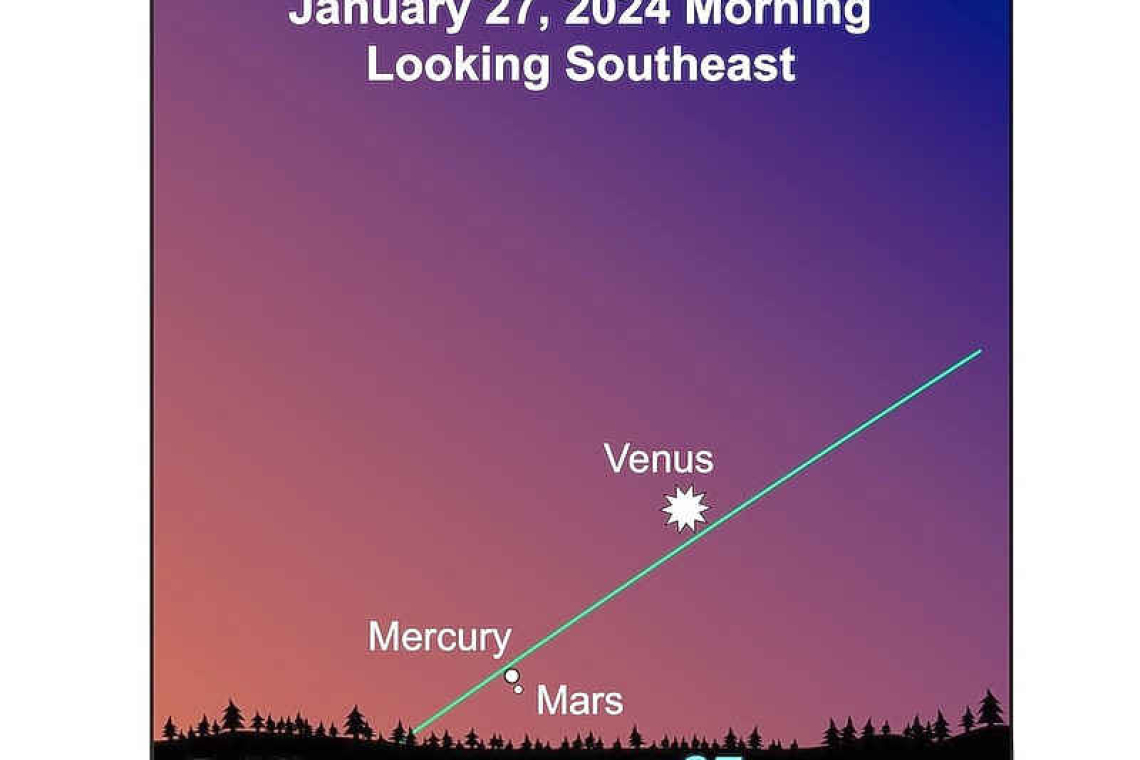~ St. Maarten’s Backyard Astronomy for January 26-28 ~
Sun rises at 6:46am
Sun sets at 6:03pm
Lunar phase: 3rd quarter, waning gibbous
Moon sets at 8:43am
Moon rises at 7:49pm
This weekend, look for a conjunction of Mercury and Mars on Saturday in the early morning sky. You can use the brilliant planet Venus to guide you to the pair – Venus rises before Mercury and leads the way for their ascent. Look to the eastern horizon about 45 minutes before sunrise for Mercury. If we are blessed with clear skies, you’ll see Mars very close to Mercury. Mars will be dimmer than Mercury at this time. Binoculars may help you find them in the morning twilight. Interestingly, this is Mars’ year to have close encounters with six different planets (close, that is, as viewed from Earth). So, this is the first of six Mars-planet conjunctions and we will keep you informed each time.
On the final morning of January, the waning gibbous moon will hang near the bright star Spica in the constellation Virgo the Maiden. Virgo is one of the largest constellations, but surprisingly tends to be easy to miss. It’s devoid of bright stars other than Spica, and although it has galaxies and star clusters, these too are dimly lit for our view. You need a powerful telescope to see that the Virgo Cluster contains some 10,000 galaxies.
Since ancient times, Virgo has been seen as a goddess of fertility. The Babylonians called her Ishtar; the Romans called her Ceres; and the Greeks called her Demeter. In Rome, she eventually evolved into Themis, the goddess of justice – and she was seen as blindfolded, holding up the scales which would weigh evidence, the scales being the constellation Libra! This image is now commonly seen as Lady Justice, seeking truth without bias or prejudice. By the way, Spica is envisioned as a grain of wheat, an allusion to fertility and rich potential.
Meanwhile, you will see Jupiter boldly standing out in the sky in the evening hours. Look high overhead about 7:00pm and note the shift to the west as the hours pass. The moon rises in the east as Jupiter approaches the western sky. Saturday night, the moon sits within the constellation of Leo the Lion.
Thank you for keeping up with the Night Sky articles, backyard astronomy designed for St. Maarten sky viewing. FYI: If you are out later on in the week, note that each star rises about four minutes earlier each day than written here, and the moon rises 50 minutes later. Night Sky is researched and compiled by Lisa Davis-Burnett. Earthsky.org is a key resource for information and images. Questions or comments? Email This email address is being protected from spambots. You need JavaScript enabled to view it.







